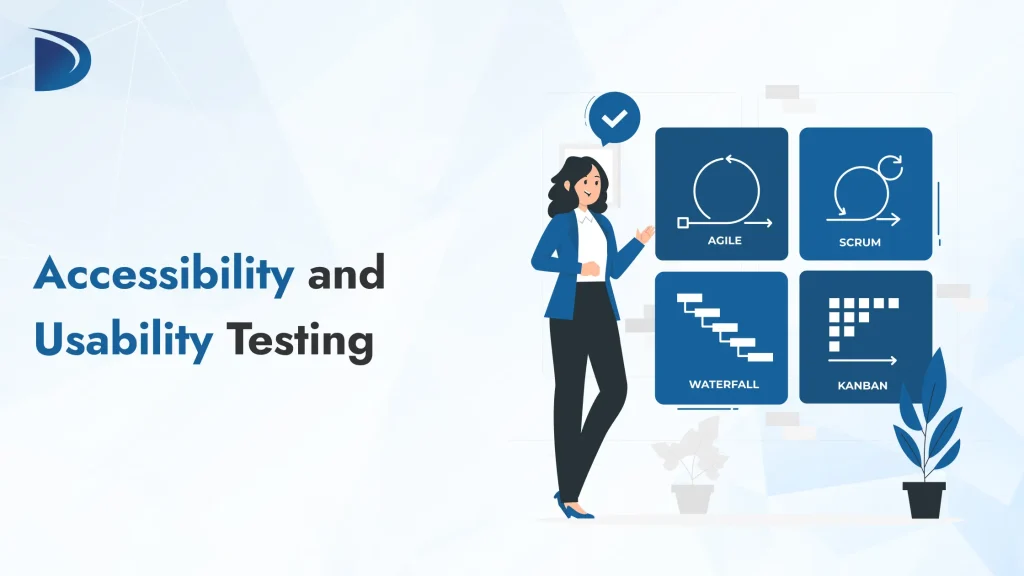Table of Contents
Accessibility and usability testing are essential steps in creating digital products that are both inclusive and user-friendly. While accessibility testing focuses on making websites and apps usable for people with disabilities, usability testing looks at how easy and satisfying the overall experience is for all users. Understanding the key differences between these two types of testing and how they work together can help developers and designers build better, more effective digital experiences for everyone.
What is Accessibility and Usability Testing?
Accessibility and usability testing are two major parts of building high-quality digital products such as websites, web apps, and mobile apps. These tests help ensure that everyone including people with disabilities can use the product easily, safely, and efficiently.
Though often mentioned together, accessibility and usability focus on different aspects of the user experience:
- Accessibility testing is about making sure that people with disabilities can access and interact with digital content.
- Usability testing checks how easy and satisfying it is for all users to use the product.
By performing both types of testing, you make your website or app more inclusive, compliant with regulations, and easier to use for a wider audience.
What is Accessibility Testing?
Accessibility testing checks if your digital product is usable by people with different types of disabilities such as visual, hearing, motor, or cognitive impairments.
It’s based on official standards like the Web Content Accessibility Guidelines (WCAG), which define rules for text readability, contrast, screen reader support, and more.
Goals of Accessibility Testing:
- Allow users with disabilities to use your product independently.
- Comply with legal regulations like ADA, Section 508, or EN 301 549.
- Improve inclusivity and equal access for everyone.
What Accessibility Testing Covers:
| Disability Type | Testing Focus Areas |
|---|---|
| Visual impairments | High contrast text, alt text for images, screen reader compatibility, zoom support |
| Hearing impairments | Video captions, transcripts for audio, visual alerts |
| Motor impairments | Keyboard-only navigation, large clickable areas, focus order |
| Cognitive issues | Simple language, consistent design, helpful error messages |
Accessibility Testing Methods:
1. Automated Testing:
- Tools like axe, WAVE, Lighthouse, or Accessibility Insights can scan web pages for common issues (e.g., missing labels, low contrast).
- Fast and good for detecting many technical problems early in development.
2. Manual Testing:
- Use keyboard only to navigate your site.
- Test with screen readers like NVDA or JAWS.
- Check tab order, skip links, and ARIA labels.
3. User Testing with People with Disabilities:
- Real-world testing is crucial.
- Involves feedback from users who rely on assistive technology (AT).
- Helps uncover issues tools cannot detect.
💡 Note: Accessibility testing should happen continuously during design, development, and before deployment.
What is Usability Testing?
Usability testing checks how easy it is for people to use your digital product. It helps you understand if users can complete tasks, find information, and enjoy their overall experience.
This testing focuses on the general user base, not just those with disabilities.
Goals of Usability Testing:
- Improve how intuitive your website or app feels.
- Find pain points that confuse or frustrate users.
- Increase conversion rates, engagement, and retention.
What Usability Testing Covers:
| Factor | What It Means |
|---|---|
| Navigation | Can users find menus, buttons, and pages without confusion? |
| Task completion | Can users complete key tasks (e.g., signing up, buying a product) without errors? |
| User satisfaction | Do users enjoy the experience? Would they return or recommend it? |
| UX design feedback | Are the layout, colors, forms, and flows helping or hurting the experience? |
Usability Testing Methods:
1. Observation:
- Watch users interact with the product.
- Note where they hesitate, get stuck, or ask for help.
2. Usability Sessions:
- Ask users to complete specific tasks while you record or measure:
- Time on task
- Error rate
- Success rate
- Satisfaction score
3. Interviews & Surveys:
- Ask open-ended questions to collect qualitative feedback.
- Use satisfaction scores (like System Usability Scale – SUS) to quantify results.
4. Analytics Tools:
- Heatmaps (e.g., Hotjar, Crazy Egg) show where users click and scroll.
- Session recordings let you watch user behavior on your site.
Accessibility vs Usability: Key Differences and How They Work Together
Though they cover different goals, accessibility and usability are closely related.
| Category | Accessibility | Usability |
|---|---|---|
| Target Users | People with disabilities | All users |
| Main Goal | Inclusive design, equal access | Easy and enjoyable user experience |
| Focus Area | Legal compliance, assistive tech usage | Navigation, task flow, user satisfaction |
| Is It Mandatory? | Often required by law | Not required, but crucial for product success |
| Best Practice | Follow WCAG, test with AT | Test with real users, use feedback loops |
How They Work Together:
- A product with high accessibility is easier to use for everyone not just people with disabilities.
- A product with good usability may still fail accessibility tests if it doesn’t support AT or proper markup.
- Combining both ensures you’re building a product that is inclusive, efficient, and enjoyable for the widest audience.
Best Practices for Accessibility and Usability Testing
- Start testing early and often don’t wait until launch.
- Use both automated and manual testing techniques.
- Include people with disabilities in testing.
- Track metrics: error rates, task times, satisfaction scores.
- Use WCAG 2.1 or 2.2 as your accessibility benchmark.
- Use tools like Lighthouse, axe, Hotjar, and usability testing platforms like Maze or UsabilityHub.
Conclusion
Accessibility and usability testing should be a continuous part of your product development process not something saved for the final stages. Start testing early and conduct it regularly to catch issues before they affect users. Combine both automated and manual testing techniques to get a complete picture of how your product performs. Most importantly, involve people with disabilities in your testing process to gain real-world insights. Track meaningful metrics such as error rates, task completion times, and user satisfaction scores to guide improvements.

